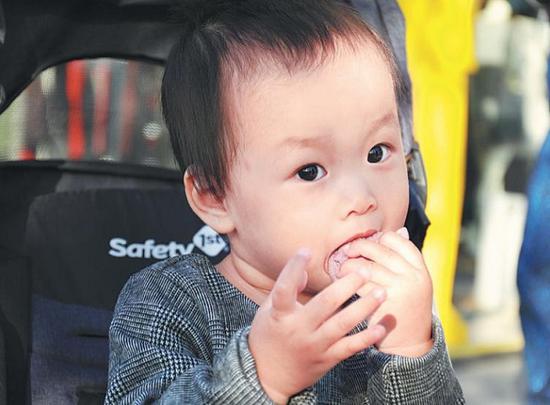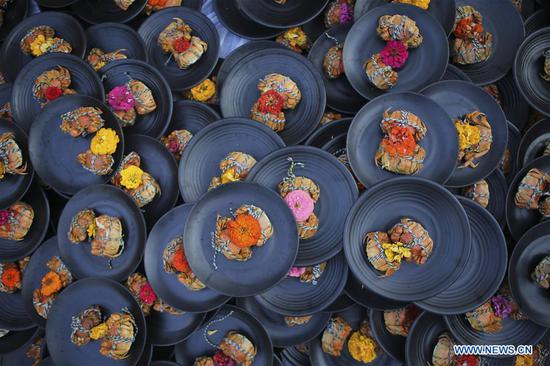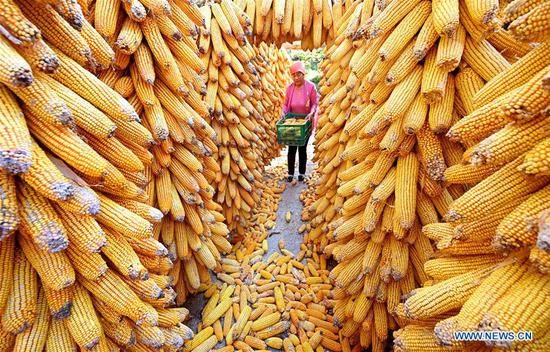
Zhang Junyao, a one-year-old girl, enjoys biscuits on her baby cart. (Photo by Wang Jingjing / for China Daily)
Even today, people surfing e-commerce platforms can easily buy snacks with packages and flavors exactly the same as those of the 1980s. "I buy this only to wake up the taste inside my heart," is a typical comment about one of the products.
Yet the snacks industry in this period was not without its problems. A lack of proper laws and regulation saw a fairly high percentage of snacks produced in illegal underground workshops. Some of the backshop boys even produced pirate products carrying fake trademarks of famous brands, or registered trademarks designed to be easily confused with the leading ones.
For example, when White Rabbit Creamy Candy really took off, some businesses registered Grey Rabbit or Small White Rabbit for their rival milk candy products. White Rabbit bared its teeth in response, registering some similar trademarks first to avoid them being registered by others, among them Black Rabbit candy. That trademark has been held by White Rabbit ever since, just to head off imitators.
The 1990s: Rise of brands
After a decade of development and competition, China's snack market had two major characteristics in the 1990s: Stricter regulation and internationalization.
In 1995, the Standing Committee of the National People's Congress, the nation's top legislature, passed China's Food Hygenie Law, which clearly required law enforcers at all levels to strike down the underground illegal workshops that produced low-quality foods or foods under false brands. Until then, quite a high percentage of these kinds of foods were actually sold in school tuckshops and targeted at pupils.
These illegal products finally disappeared from the market through stricter enforcement. They might still exist here and there, far from the main urban areas, but the total amount has decreased hugely.
Global brands also jumped on the bandwagon, rushing into China. Spanish brand Cola Gao made its first appearance in 1990 and ruled the roost for quite a few years. A nutritious product made of cocoa powder, it gives out smell of chocolate when brewed in hot milk, making it a popular drink with kids.
Yao Wenjun, born in 1991 and now working in Shenzhen in southern Guangdong province, witnessed the changes as a girl. "During my six years at primary school, the number of foreign snacks brands near my school grew from none to three, or one every two years", she said with a smile. "Every snack shop gave us a feeling of happiness."
US food giants KFC and McDonald's were among the international brands that moved into China during the period, along with rivals such as Subway and PizzaHut. Interestingly, the difference in the meaning of the word "lunch" for Chinese people and Westerners made their roles different in China, too. For many in the West, lunch is often a sandwich or roll, ordered to go and eaten on the run within half an hour.
In China, however, lunch is a substantial meal-no less important than breakfast or supper. As a result, the fried chicken and sandwiches sold by KFC and McDonald's were seen more as leisure snacks when they first came out in China and their bestsellers were fried chips.
New century: Health worries
An inevitable result of people eating more and more fried chips and other high-caloried snacks, both domestic and global brands, is obesity. According to the international Danone Institute, which specializes in nutritional research, the obesity rate for Chinese 7-18 years old had risen eight times in 2000 compared with 1985; for the subgroup aged 17-18 years, the rate was up 21.5 times.
That's why, since the beginning of the new century, "control" has become a key word in the lexicon of parents, reflecting their new attitude towards snacks for their family. Some parents have cut back on their kids' weekly allowance or pocket money, while others have imposed strict discipline at home and set limits on the amount of snacks their children can consume.
Yuan Jinghao and Zhu Xinyu, two cousins born in 2008 and 2009, have experienced both measures. Yuan is allowed to spend only 20 yuan a week on snacks, while Zhu is allowed to have only one small bag of snacks each day, with a weight not exceeding 150 grams.
Back at the Gao residence, baby granddaughter Zhang Junyao might still be wearing diapers, but she's already following rules, because of her obvious taste for snacks.
For her health, she is only allowed to take fruits, a small cup of yogurt, and two kinds of children's biscuit besides her meals.
"It seems a natural desire for children to want snacks", Goa said.
"But the health for my granddaughter is the most important thing and I must be strict in implementing the rules."


















































